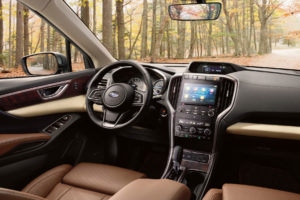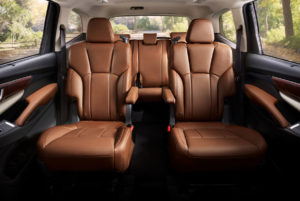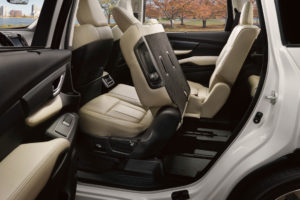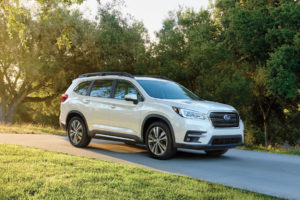Subaru’s first seven-seat SUV was the Tribeca, a generic-looking vehicle named after a well-known neighbourhood in Manhattan. It was a weird name for a vehicle better-suited to the suburbs than a crowded urban setting. Most crossover shoppers were unimpressed.
But the market for mid-size SUVs with three rows of seats is an important one, so Subaru is back for a second try with the Ascent. It’s hard to get creative when styling a practical family vehicle, so the Ascent still doesn’t stand out, but a strong resemblance to the Forester and Outback models helps identify it as a Subaru.
Design and interior space
Middle of the pack sizing: Subaru has its eye on the heart of the mid-size SUV segment with the Ascent SUV. It’s longer than the Toyota Highlander, Hyundai Santa Fe XL and Honda Pilot, and shorter than the Nissan Pathfinder, Chevrolet Traverse and Volkswagen Atlas.

Narrow front seats: From the front seats, the Ascent’s cabin feels narrower than many of its competitors. The specs reveal that in fact it is, especially compared to the Pilot, Atlas and Traverse. The Subaru Ascent’s front seats offer less hip room than the Pilot and Traverse, and less shoulder room than the Traverse.

Wide rear seats: Subaru saved its space-efficient engineering efforts for the second row, where there’s more hip room than in either the Pilot or Traverse. That width matters more in Ascent models with the standard, three-place bench seat. Our Premier trim tester had standard captain’s chairs that are optional in less-expensive models.

The Ascent’s rear doors swing out nearly 90 degrees to reveal wide openings that ease rear-seat access.
It’s worth noting the Ascent could soon be out-sized by a couple of the models we mentioned above. Hyundai will soon launch the 2020 Palisade to replace the Santa Fe XL, and the Toyota Highlander and Nissan Pathfinder are among the segment’s older designs.

Small third-row seats: Like many mid-size crossover SUVs, the Subaru Ascent’s third row is not particularly spacious. There’s enough room for kids or small adults, but no one of average height or taller will want to spend a lot of time back there.
Cargo space: Typically, there’s not a lot of trunk space behind the third row seats. Stowing them away turned our test car into a four-seater with a vast cargo area.
Powertrain and performance
- New turbocharged engine: The 2019 Subaru Ascent is the first model to use the company’s new, 2.4L turbocharged four-cylinder engine. It provides strong acceleration with good low-end torque. In normal driving, the continuously variable transmission (CVT) changes ratios smoothly. Push the accelerator to the floor and the CVT imitates the way a traditional transmission shifts between fixed ratios.We drove the Ascent during a particularly cold week in February and the engine struggled to meet our demands for cabin heat. Chilly temps also yielded average fuel consumption of 14.0 L/100 km, which is thirsty next to Subaru’s estimates of 11.9/9.0 L/100 km (city/highway).
- Symmetrical AWD: As with most other Subarus, one of the Ascent’s draws is the company’s AWD system. It powers all four wheels all the time, while most crossover SUVs don’t engage AWD traction until the front wheels spin. As a result, our Ascent tester felt sure-footed in heavy snow.
- X-Mode: The Ascent is not built for heavy-duty off-roading, but has a few features to enhance off-road performance. Subaru says X-Mode makes throttle response more gradual to prevent wheel spin in slippery conditions. There’s also a hill descent control system that automatically limits the car’s speed down steep slopes, like low-speed cruise control.
- Firm ride, quiet cabin: We found the Subaru Ascent’s ride firm and uncomfortable on rough pavement. In theory, that could translate into sharp handling in dry conditions. In practice, it snowed most of our week in the Ascent, so we had no opportunity to test that.
- Heater controls: Subaru includes heated front seats and three-zone automatic climate control in all Ascent models. Touring trim adds rear-seat heater controls and a front wiper de-icer. Limited and Premium trims add a heated steering wheel and heated second-row seats.
Note that we seem to be in the minority in finding the Ascent’s ride too harsh. Other car reviewers we know judged the suspension to be quite compliant. That’s why it’s important to take a test drive and evaluate a car’s performance for yourself.

One of Ascent’s strengths is its quiet cabin. Not much engine or road noise gets inside, even at highway speeds. That’s particularly remarkable given our tester’s aggressive winter tires, designed for grip over a quiet ride.
Safety
- Eyesight active safety: From a $36,000 starting price, all Subaru Ascent trim levels come standard with the company’s Eyesight safety suite. It comprises collision detection with automatic braking, adaptive cruise control and lane-departure warning with lane-keep assist. Subaru adds blind-spot monitoring, rear cross-traffic alert and reverse automatic braking in the $41,000 Touring trim.
- LED headlights: The $46,500 Ascent Limited gets LED headlights that respond to the steering to aid visibility in turns. Our $50,000 Ascent Premier test vehicle also had a front-view parking camera and a rear-view camera mirror that eliminates blind spots.
- Camera: Subaru approaches that last feature differently than other car makers. In the Ascent, the camera lives inside the back window. Keep the glass clean with the rear wiper and its view is clear. In other vehicles with a camera-based mirror, the camera lens either requires its own washer, or simply stays dirty.
- Eyesight: Eyesight continues to be one of the best active car safety systems on the market. Our only complaint is that the lane-keep assist makes abrupt steering adjustments that can be distracting.
Competitors, pricing and value
In mid-size crossovers, the most obvious standard feature differences are in safety equipment. Here’s how the Ascent stacks up against a few key competitors.
1. Honda Pilot: Honda equips its three-row crossover with the same safety features as the base Ascent, but for $5,000 more. Honda adds blind-spot monitoring and rear cross-traffic alert at well over $50,000.
2. Nissan Pathfinder: All Pathfinder models come with automatic braking from $33,200. Nissan adds a blind-spot monitor and rear cross-traffic alert at close to $40,000.
3. Chevrolet Traverse: Chevrolet puts blind-spot and rear cross-traffic alerts in the Traverse at $48,000. Low-speed automatic braking and lane-keep assist are included for about $54,000. Chevrolet asks $60,000 for a Traverse with all-speed automatic emergency braking.
4. Toyota Highlander: Starting at $37,300, Toyota fits every Highlander with automatic braking, adaptive cruise and lane-departure alert with steering assist. You have to pay more for blind-spot and rear cross-traffic monitoring.
If future costs are a concern for you, consider the Ascent’s standard tire sizes. Convenience and Touring use 18-inch tires, and Limited and Premier have 20-inch tires that will be more expensive to replace. Larger wheel and tire combinations also tend to ride more harshly.
2019 Subaru Ascent Specs:
- Vehicle category: Mid-size SUV/crossover
- Engine: 2.4L four-cylinder, turbocharged; 260 hp, 277 lb-ft torque
- Transmission: Continuously variable automatic
- Notable standard features (base model; MSRP: $35,995):Three-zone automatic climate control, eight-way power driver’s seat, heated front seats, six-speaker stereo with 6.5-inch infotainment touchscreen, adaptive cruise control, pre-collision braking, lane departure warning and lane keep assist.
- Notable standard features (Premier trim, as tested; MSRP: $49,995): Sunroof, heated rear seats, heated steering wheel, front parking camera, rear camera mirror, leather seating, ventilated front seats, navigation, 14-speaker stereo, 8.0-inch infotainment touchscreen.
- Fuel economy, ratings (l/100km, city/highway): 11.6/9.0
Conclusion
The 2019 Subaru Ascent is a more cohesive crossover than its Tribeca predecessor. Subaru got the basics right with good interior space and a quiet cabin. We like the new turbo engine’s performance; our fuel economy was not great, but we blame that mostly on cold weather.
If you’re in the market for a family vehicle with all-weather confidence, the Subaru Ascent should be on your test drive list.


